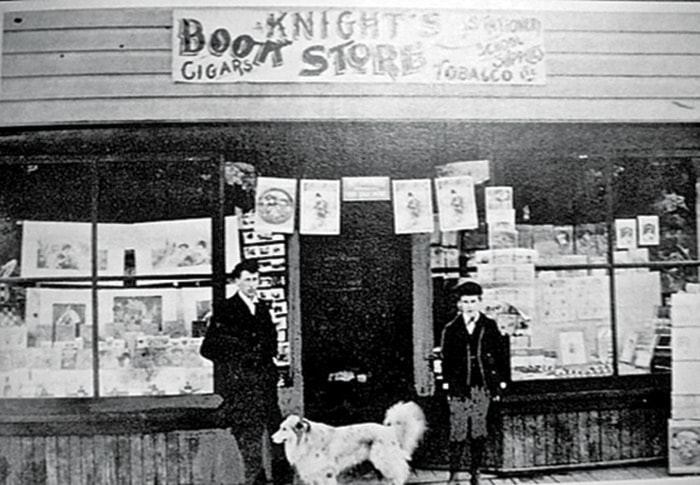Part 1 of this article reviewed the years before incorporation and the story of Oyster Harbour. In this section, we will examine the first two decades of the town of Ladysmith and the development of First Avenue as the city centre.
When James Dunsmuir decided to build a seaside bedroom community for the Extension coal miners, he first considered South Oyster (Saltair) for the town site.
In the end, he chose the hillside opposite the bay remarking, “We shall lay out the town site there, for I doubt the land is fitting for anything other than houses and streets.”
Once the spur line to Extension and the coal bunkers were constructed, work began on the new settlement.
However, unlike the more gradual expansion of towns like Duncan or Langley, Ladysmith, was “a direct transplantation of an urban society into a wilderness setting.” An instant community. (Goodacre 1991)
Dunsmuir approved a typical British town design with a Market Square and ‘High’ Street as the centre of commerce.
The layout had 140 city blocks stretching from Stony (Rocky) Creek to First (Holland) Creek and took into consideration the shoreline industry already in operation. Homes and boarding houses for the miners, along with light industry and the 19th-century equivalent of “convenience stores,” would spread up the slopes from Esplanade as the town expanded.
James Dunsmuir kept a close eye on the new town.
E&N’s first telegrapher and pioneer resident, Nathan Dougan, recalled having tea with Dunsmuir during one of his many visits. Dougan operated out of the Maude, a private railway car used as the first E&N station in Oyster Bay.
“Dunsmuir dropped off his special train and after giving the whole construction searching scrutiny, he joined us in the office for refreshment. He was in his late middle ages, with a clipped reddish beard and quite unconcerned about dress, with a harassed visage as though carrying a load of care. He asked many questions but said little otherwise.”
With no shortage of labour, Ladysmith grew quickly.
The 1909 Vancouver Island Gazetteer records a population of 3,000 — “not including Indians and Orientals.” City sewage systems, electric lighting plant, as well as telephone and telegraph services, were in operation only five years after incorporation.
A visiting dignitary in 1910 told the editor of the Chronicle:
“I have been coming west since 1891 and visited every town of importance between Port Arthur and the Pacific Coast. Never have I seen so much accomplished so quickly. It is like the story of Aladdin’s lamp, and to carry the simile further, you have the best electric lights I have ever seen on my travels.”
Thirteen of the 14 hotels in Ladysmith had saloons that did a roaring business with miners, loggers and sailors. But at the same time, tea shops and ice cream parlours scattered around town attracted young families and courting couples in their finest Edwardian attire.
From Roberts Street along First Avenue to Buller, there were bakeries, milliners, tailors, jewellers, barbers and bakeries.
Advertisements in the Chronicle assured residents that there was “no need to travel to Nanaimo or order from Victoria to obtain the latest in fashion and conveniences at the most reasonable prices.” The plea then —- as now — was to “shop locally!”
Merchants would often stay open late in the evening on weekdays to accommodate the miners returning from Extension on the 6 p.m. train. Businessmen like Grant Jessup, George Roberts, John Bickle, Ed Jones and J.A. Knight would wait at their shop doors to greet passersby if they were not busy in their stores serving customers.
“Downtown” was a place to shop, meet friends, pick up mail, pay a bill, repair your shoes, rent a buggy or exchange gossip.
In the early years, Ladysmith had three movie houses competing for business. The Opera House, Gem, and Rialto theatres had prize draws and raffles to attract customers. Singers, storytellers or musicians would entertain the patrons while reels were being changed.
People also went downtown for society meetings. The Eagles, the Owls, the Masons and the Oddfellows, were all established in Ladysmith by 1920.
Viola Cull recalled “ladies of the various lodges in their long white dresses carrying lanterns, moving among tree stumps in the evening. They were jokingly called the ‘glowworms’ or the ‘fireflies.’”
Walking downtown in those days had to be done carefully. Although wooden boardwalks had been constructed in front of many businesses, First Avenue did not receive cement sidewalks until 1925. Street crossings after a rainstorm (or a team of horses) could be disastrous!
In 1912, the future for the new city looked bright indeed; but there was labour unrest in the coal mines of Vancouver Island and clouds of war on the horizon.
Ed Nicholson. Ladysmith and District Historical Society
NOTE: A priority for the Historical Society (LDHS) is to record and document as many of the family histories as we can.
The Ladysmith Archives, located under Tim Hortons on First Avenue, maintains a separate file for each family with roots or long-term residency in our town.
If it does not already exist, the LDHS would be delighted to start a file for your family. Family photos and correspondence (which we can copy and return to you) are most welcome and are an integral part of Ladysmith’s legacy. Call us at 250-245-0100 or e-mail us at ldhsarch@shaw.ca if you are willing and interested in sharing these treasures with your town.

